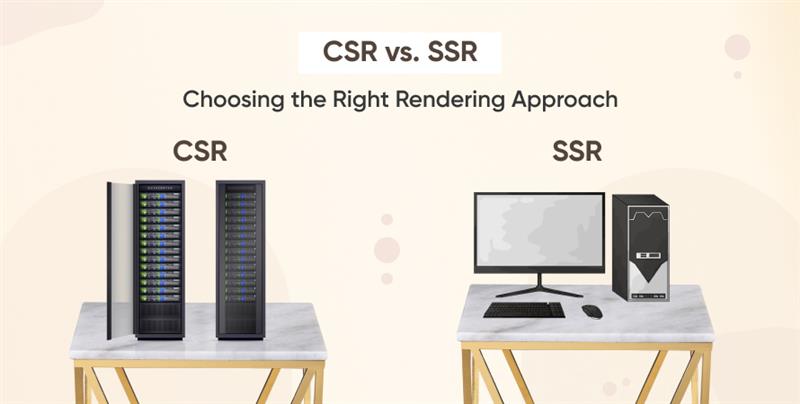SSR vs. CSR: Choosing the Right Rendering Approach



Introduction
As the web evolves, so do the strategies developers use to deliver content to users. Among the most fundamental decisions when building a modern web application or website is choosing the appropriate rendering method. Rendering—how a web page is delivered and displayed in a browser—has a direct impact on page speed, user experience, search engine visibility, and even business metrics like conversions.
Two primary rendering strategies dominate today’s front-end landscape: Client-Side and Server-Side Rendering (CSR). Understanding the difference between client-side vs server-side rendering, their trade-offs, and how each impacts performance is essential for making informed technical decisions.
In this guide, we’ll walk you through both rendering approaches, compare their key characteristics, explore their impact on Core Web Vitals and SEO, and help you decide which is right for your specific use case.
What is Rendering in Web Development?
Rendering refers to the process of transforming code into a visual interface a user can interact with in the browser. In web development, it involves assembling HTML, CSS, and JavaScript to form a complete page.
Browsers rely on HTML markup to understand what to display. However, how that HTML gets created and delivered can vary dramatically. This is where the distinction between SSR and CSR becomes critical.
In short, rendering defines when and where the HTML content is generated:
- On the server (SSR) before it reaches the browser
- On the client (CSR) after the JavaScript executes in the web browser
Choosing the right rendering strategy affects performance, SEO, accessibility, and the overall user experience.
What is Server-Side Rendering (SSR)?
Server-Side Rendering (SSR) means a technique where the HTML of a web page is generated on the server in response to each request. When a user visits a site, the server compiles the HTML and sends it to the browser. This allows users and search engines to immediately access the content.
How SSR Works – Step-by-Step
- A user types a URL or clicks a link.
- The browser sends a request to the server.
- The web server processes the request and renders the HTML for that page.
- The fully rendered HTML is sent to the browser.
- The browser displays the page and executes any necessary JavaScript for interactivity.
Benefits of SSR
- Improved SEO: Content is immediately available to search engine crawlers.
- Faster First Contentful Paint (FCP): Users see meaningful content faster.
- Better for dynamic content: Suitable for frequently updated or personalized content.
Limitations of SSR
- Higher server load: Rendering on the server for each request can strain resources.
- Longer Time to Interactive (TTI): Although HTML loads quickly, JavaScript must still be parsed and executed.
- Complex caching strategies: Requires effective CDN or server-side caching for scalability.
What is Client-Side Rendering (CSR)?
Client-Side Rendering (CSR) relies on the browser to build the user interface after downloading a minimal HTML shell and JavaScript bundle. The browser runs JavaScript to render the page dynamically.
CSR is common in single-page applications (SPAs) where navigation and data fetching are handled entirely on the client.
How CSR Works – Step-by-Step
- The user requests a page.
- The server sends a basic HTML file with links to JavaScript files.
- The browser downloads and executes JavaScript.
- The JavaScript builds and renders the UI dynamically on the browser.
- Additional interactions happen without full page reloads.
Rendering from client side means that the browser is responsible for constructing the web page after it downloads and executes the necessary JavaScript.
Benefits of CSR
- Highly interactive experiences: Ideal for applications with dynamic and personalized UIs.
- Reduced server load: The server handles fewer rendering responsibilities.
- Efficient for returning users: Once the JavaScript is cached, navigating between pages is fast.
Limitations of CSR
- SEO challenges: Crawlers may struggle with or ignore content rendered via JavaScript.
- Slower initial load: Blank pages or spinners can appear while JavaScript loads.
- Poor performance on low-end devices: Heavy JavaScript execution can impact mobile users.
Server Side vs. Client Side Rendering: Key Differences
Let’s dive into how client vs server-side rendering compare across different metrics that matter in real-world applications:
| Feature | Server-Side Rendering (SSR) | Client-Side Rendering (CSR) |
|---|---|---|
| Initial Load Speed | Faster content display | Slower due to JavaScript parsing |
| SEO Friendliness | High – Content is crawlable | Low unless optimized with prerendering |
| User Interactivity | Slower post-load | Immediate after load |
| Server Load | Higher – renders HTML on each request | Lower – offloads rendering to client |
| Scalability | Requires caching, complex infrastructure | Easier to scale statically |
| Developer Complexity | Moderate – familiar HTML templating | Higher – requires frontend frameworks |
The Role of SSR and CSR in Core Web Vitals
Core Web Vitals are a set of performance metrics used by Google to evaluate real-world user experience. These include:
- Largest Contentful Paint (LCP) – measures loading performance
- First Input Delay (FID) – measures interactivity
- Cumulative Layout Shift (CLS) – measures visual stability
SSR and Core Web Vitals
SSR typically results in a faster LCP since HTML is served fully formed, enabling faster visual feedback. However, FID may suffer if the page relies heavily on client-side JavaScript for interactivity.
CSR and Core Web Vitals
CSR tends to delay LCP because content is built after JavaScript execution. It can also lead to higher CLS if elements shift during hydration. However, well-optimized CSR with code-splitting and lazy loading can improve FID.
Summary
- SSR favors fast content visibility, better for static or semi-dynamic pages.
- CSR favors dynamic interactivity, better for apps and tools.
Both require performance optimization to score well in Core Web Vitals.
Hybrid Rendering: Best of Both Worlds
Many modern frameworks now support hybrid rendering—a mix of SSR and CSR, or static generation with hydration.
This approach allows developers to selectively render some parts on the server while others are handled on the client, achieving a balance between performance and interactivity.
Common Hybrid Techniques
- Static Generation + Hydration: Pre-render pages at build time, then hydrate on the client (e.g., Next.js SSG).
- Incremental Static Regeneration: Update static content after a set interval.
- Server Components: Render components on the server, selectively hydrate client components (React Server Components).
Hybrid rendering offers a practical solution when both SEO and interactivity are priorities, and when scaling demands flexible performance strategies.
How to Choose the Right Rendering Approach
There’s no universal answer. The best rendering method depends on your specific needs. Consider the following factors:
1. Project Goals
- Are you building a content-heavy website (blogs, marketing pages)?
- Is your focus an application with dynamic UIs and user interactions?
SSR is often better for static and SEO-driven content, while CSR works well for app-like functionality.
2. SEO Requirements
If organic search traffic is vital, SSR or hybrid rendering is usually the best approach. For internal dashboards or tools with login walls, CSR may suffice.
3. User Expectations
Users expect fast, seamless experiences. SSR gives faster first impressions, while CSR can deliver smoother in-app navigation.
4. Performance Budgets
CSR requires significant JavaScript optimization to stay within acceptable Core Web Vitals. SSR needs smart caching to avoid performance bottlenecks.
5. Development Resources
SSR might be easier for traditional back-end teams, while CSR usually requires a deeper knowledge of modern JavaScript frameworks.
Common Myths Around SSR and CSR
Let’s debunk a few common misconceptions:
“CSR is always faster.”
False. CSR can feel fast once loaded, but initial page loads are often slower due to JavaScript execution.
“SSR guarantees perfect SEO.”
Not necessarily. SSR improves crawlability, but SEO still depends on structured data, meta tags, accessibility, and content quality.
“CSR is outdated.”
CSR remains relevant, especially for applications where real-time interactivity and SPA navigation are critical.
“SSR is too complex.”
Modern frameworks have made SSR more approachable, and with caching, it can scale effectively.
Use Cases for SSR and CSR
Use SSR When:
- SEO is a top priority
- You serve content to unauthenticated users
- You need fast initial paint for marketing pages
- Your site content is frequently updated but not highly interactive
Use CSR When:
- Your site is a complex web application or dashboard
- SEO isn’t a concern (e.g., behind a login)
- You require high interactivity, animations, or user state changes
- Your team specializes in frontend development
Future of Web Rendering
Rendering strategies are evolving rapidly:
- Edge rendering: Moving SSR closer to the user via CDNs
- Streaming HTML: Sending partial HTML while the rest loads
- Progressive Hydration: Delaying hydration of non-essential components
- React Server Components: New patterns that combine server and client logic efficiently
The future will likely involve adaptive rendering, choosing the best method based on user location, device type, and page type dynamically.
Conclusion
Choosing between server-side rendering vs client-side rendering is a strategic decision that depends on content, audience, performance, and long-term scalability.
SSR is ideal for visibility and quick loading, while CSR empowers richer, app-like experiences. Hybrid approaches give developers the flexibility to leverage the strengths of both.
If you’re unsure which rendering method suits your project, or if you’re looking to improve performance and SEO with modern techniques, consider working with experts. Hire Core Web Vitals Consultants to make informed, high-impact decisions for your website.
Frequently Asked Questions (FAQs)
Server-side rendering generates HTML on the server before sending it to the browser. Client-side rendering builds the HTML dynamically in the browser using JavaScript after the page loads.
SSR is generally better for SEO because it delivers complete HTML to search engine crawlers. CSR requires additional configuration to ensure search engines can index JavaScript-rendered content.
Yes, many modern frameworks support hybrid rendering. You can pre-render certain pages server-side and use CSR for highly interactive components.
Not necessarily. Both approaches require security best practices. However, SSR reduces exposure of sensitive logic to the client, which can add a layer of protection.
SSR can provide faster initial loads on mobile networks, while CSR may struggle with large JavaScript bundles, especially on low-powered devices. Optimizing code is essential in both cases.